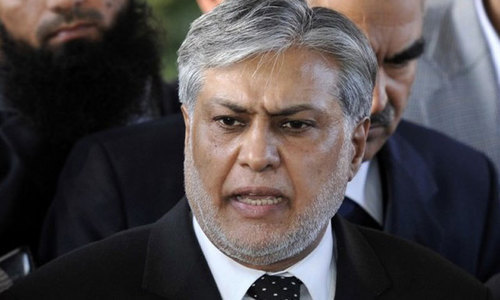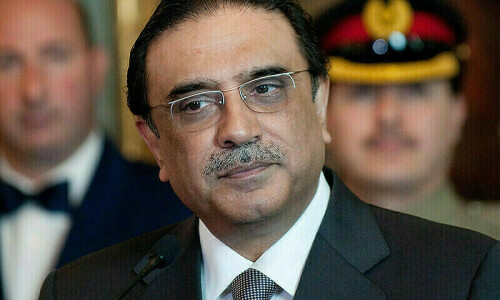
Ever since the decision of the incumbent finance minister to adopt a ‘strong’ rupee policy in December 2013, and convert the regime into a near-fixed exchange rate one, the resulting overvaluation and the accompanying fall in exports have generated intermittent debate about the merits and demerits of the move.
Since then, the rupee has appreciated by nearly 27 per cent in real effective terms according to State Bank data, while the IMF estimates the Pakistani currency is overvalued between 10-20pc. Pakistan’s exports have declined nearly 20pc in US dollar terms, while imports have risen 18pc during this period. Excluding food, energy and capital goods, imports have surged 22pc.
To correct the large, and protracted, misalignment of the rupee in the currency markets, the State Bank finally made a move on July 5, effectively devaluing the currency by 3.1pc against the US dollar. This move was technically correct as well as brave on the part of the acting governor, but since it was politically unsustainable it proved to be disruptive for the financial markets. Predictably, it provoked an angry response from the finance minister as well as heavy doses of moral suasion and intervention in the currency markets to bring the rupee near its pre-devaluation level in the inter-bank market. In the event, it also exposed the limits of the much-touted independence of the central bank, which has not escaped the atrophy other institutions have experienced under this PML-N government.
Debate regarding the rupee is ignoring two 800-pound gorillas in the room.
The State Bank’s move and the government’s response have finally generated deeper discussion and debate that this issue deserves. Most of the arguments against a depreciation of the rupee revolve around the following ‘observations’:
— Exports have not been helped by past devaluations of the rupee.
— Any weakness of the rupee generates domestic inflation as well as a large fiscal cost.
Before responding to these arguments, it is important to point out an underlying narrative that pervades almost every aspect of Pakistan’s economic policymaking. No matter which prescription derived from ‘standard’ economic theory and models, or international best practice, is advocated for Pakistan, it is almost universally met with one response within the country: the ‘ground reality’ in Pakistan is different. The intrinsic argument is that somehow the laws of physics, economics, biology etc. do not apply to, or in, Pakistan!
In the case of exports, when evaluating the effect of past devaluations, commentators tend to focus ‘tactically’ on the change in US dollar exports from Pakistan between two points in time to determine if there was a positive correlation or not. However, in doing so, they tend to miss the elephant in the room: the exchange rate is a fundamental price that determines the relative attractiveness of two sectors in the economy — exports versus imports. Hence, a misalignment of the exchange rate over a protracted period will show up in one sure shot way — the export sector will shrink relative to the rest of the economy as resources are allocated away from it towards the more lucrative non-tradable sector (in case of an over-valuation).
This is exactly what has happened in Pakistan as the merchandise export sector has shrunk to 7pc of GDP, from around 13pc in the early 2000s (a loss of 6pc of GDP), while all its trade competitors have seen much larger increases in the size of their export sectors over the same period. I have been consistently pointing out this alarming trend but to little avail. Even tactically, it is worth considering the spate of competitive devaluations Pakistan’s trade competitors have undertaken over the past few years to keep their products competitive in international markets.
At its extreme, the centrality of a competitive exchange rate to even a large, advanced trading economy such as Japan is highlighted by the fact that despite merchandise exports of $645 billion — out of which $95bn are high-tech products — engineering a weakening of the yen (via looser monetary policy) is one of the three ‘arrows’ of Prime Minister Shinzo Abe’s economic revival plan since 2012.
And while the discussion regarding the purported effects of a misaligned exchange rate tends to focus exclusively on exports, the impact on imports and on relative prices within the economy is usually ignored. Equally important, Pakistan’s policymakers need to rethink the exchange rate policy with reference to another 800-pound gorilla in the room — CPEC. The myriad concessions offered to Chinese investors, including favourable tax treatment viz the overtaxed and overburdened Pakistani competitors, means that one of the few policy handles the government has to provide a measure of protection to domestic industry (other than to reduce its tax burden) is to operate with a weaker exchange rate — especially in the context of a one-sided free trade agreement.
In conclusion, the exchange rate policy is one instrument among a cluster of policies required to boost exports. The full spectrum of policies includes fiscal, taxation, monetary as well as commercial policy. The misalignment of much of the policy framework, making it have an intrinsic anti-export bias, is very likely to have blunted the effect of exchange rate policy in the past. However, a counter-factual argument can also be presented — ie if the exchange rate had not weakened, would Pakistan’s exports have even attained the levels that they did or would they have been lower?
Whatever the answer, in the final analysis, it is fair to say that the exchange rate is a fundamental ‘price’ in the economy, and getting it right is essential not just for boosting the export sector but also for providing a measure of protection to domestic industry.
The writer is a former economic adviser to government, and currently heads a macroeconomic consultancy based in Islamabad.
Published in Dawn, July 21st, 2017














































